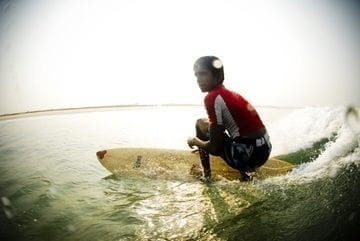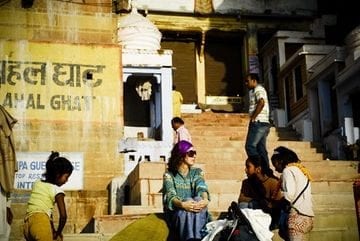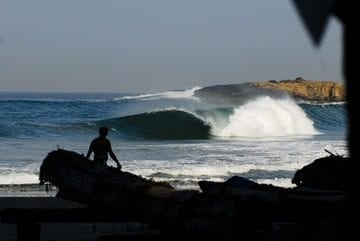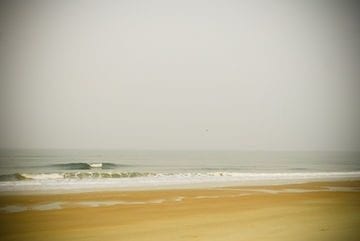Often overlooked as a surfing destination, India is home to 7,000 kilometers of primarily untouched coastline and only a handful of surfers. A break away from the typical surf adventure, navigating your way through India with a surfboard and backpack makes for a truly memorable travel experience.
A destination that challenges even the bravest surf travelers, take a look at our tips for an unforgettable Indian surfari.

A destination that challenges even the bravest surf travelers, take a look at our tips for an unforgettable Indian surfari:
Route Suggestion
Access to the country’s surf breaks is painfully difficult, and exploring the whole country’s coastline would take you half a year. For a mixed bag of waves and cultural adventure, start in Delhi and take an overnight train to sacred Varanasi, fly down to the mid-west coast and stay in a surfing Ashram in Mulki, then jump on another train and soak up the southern beauty of Kovalam.

When to Go
Dec through to March is good for sightseeing and long boarding, with very little rain and warm temperatures. The pre-monsoon season is from May until June, producing hot temperatures and good swells. The big wave season starts in July and extends right through the monsoon season, bringing strong winds, rain and big surf.

Equipment
Whilst travelling light is the key to getting around India, there are absolutely no surf shops so take a couple of boards in a sturdy travel bag if you can manage the extra load. Throw in several blocks of wax, sunscreen and a solar repair kit, fins, leg ropes and a couple of fin keys. During the off season waves are generally gentle and small, but can pick up on full moon swells so a good all-round board is best. A little extra length will get you into the bigger surf during the monsoon season.
Cover up
Hinduism accounts for just over 80% of the population in India, so ladies leave the Brazilian bikini at home and cover up in the water with a rash guard and knee-length shorts. Around Kovalam visiting Europeans are famed for their scantily clad sunbathing antics, and on weekends the shoreline is crowded with local men getting their perv on.
Health and Safety
Medical: India requires taking a little bit more care on the road. Accompany any medications with a letter from your doctor, boost your immune system with a good daily multivitamin, and if you need to visit a medical clinic be sure to get a second opinion to avoid large bills connected to travel insurance scams.
Insurance: Take out good travel insurance before you go, covering you for unlimited medical expenses, unforeseen travel complications and for lost or damaged luggage.
Water: Bottled water is generally safe if the lid is sealed; check to see both the cap and bottom have not been tampered with and crush your used bottle to discourage future tampering. Water purification tablets are a good idea.
Food: Unless you have a stomach of steel, take care when eating from street vendors, particularly in rural areas. For snacks opt for fruit and vegetables you can peel or pre-packaged foods.
Security: Surfboards are quite foreign to Indians, but are associated with wealth. Take care of all your possessions on long distance trains, lock your hotel rooms and be aware of pick pockets particularly in crowded places.
Transport
Flights: Qantas and Jet Airways fly code share daily via Singapore to Delhi from Perth, Adelaide, Melbourne, Sydney, Brisbane, Cairns and Darwin. Daily services via Singapore to Mumbai operate out of Perth and Sydney (subject to change).
Trains: Trains are an exciting way to get around and more comfortable than long distance busses. First class offers more private and secure cabins and the added bonus of ordering food on board, whilst the lower classes decline in comforts but will no doubt boost the overall cultural experience. Book online to avoid sold out seats.
Local: Autorickshaws are cheap, exhilarating, and a great way to get around the cities and villages, but if you need to travel far hire a taxi for the day. Slip some tie downs and extra rope in your board bag to secure your surfboard on the roof.
Accommodation
In and around major cities like Delhi, it pays to pre-book reputable hotels offering airport pick-up services. There are numerous options close to New Delhi station, or consider the cultural Old Delhi area. Cheap accommodation in rural India is abundant but be warned; booking in advance doesn’t necessarily guarantee you a room especially during cultural festivals.
Ashram Surf Retreat: Situated in the mid-west coastal town of Mulki, Karnataka, India’s only surfing Ashram offers guests comfortable retreat style accommodation, all meals, surfboard hire and private transfers to empty surf points along the coast. Book well in advance.
Kovalam: A sultry beach side town in India’s south west, Kovalam, in Kerala, offers everything from budget to resort style rooms along three beaches spread over 17 kilometers of coastline. Up-market accommodations require advance bookings whilst low-end rooms are generally in abundance and you may be able to haggle the nightly rate.

Visas and Money
Visas: Australians can stay in India on a single-entry tourist visa for up to 6 months and applications can be made online.
Money: The Indian Rupee is reasonably weak against the Australian dollar, making India a great budget destination for Aussie surfers. Similarly, living and travel expenses are cheap allowing for a longer stay and more waves.
